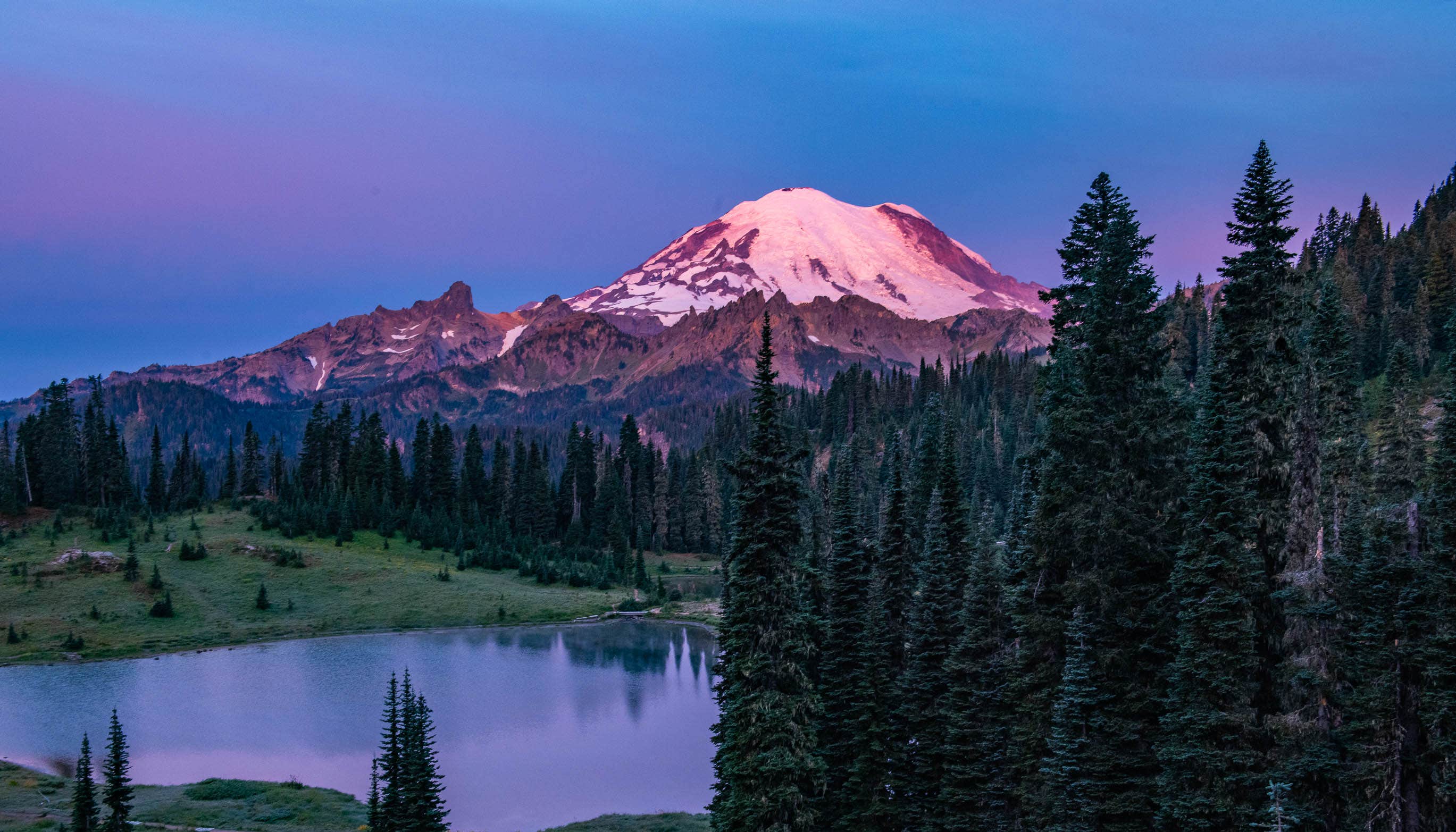Mount Rainier National Park Guide
Mount Rainier National Park offers camping experiences ranging from lush old-growth forests to high-alpine meadows across its four campgrounds. Three auto-accessible campgrounds (Cougar Rock, Ohanapecosh, White River) provide nearly 480 sites, while a fourth walk-in camp at Mowich Lake offers primitive tent pads by a pristine mountain lake. Beyond park boundaries, additional camping options await in surrounding national forests and nearby communities. Each campground presents a unique setting -- whether it's steps from Paradise's wildflower trails, along the crystalline Ohanapecosh River, or in the shadow of Sunrise's glaciated slopes. This guide covers everything you need to know about planning, booking, and enjoying a Mount Rainier camping trip, with practical advice from campers who've been there.
Mount Rainier National Park Camping at a Glance
All Mount Rainier campgrounds require reservations during peak summer weekends, except White River which remains first-come, first-served only. Cougar Rock and Ohanapecosh Campgrounds release reservable sites on a 6-month rolling window (opening at 7:00 AM Pacific Time) for late June through early September. These popular sites can book out within minutes. For 2025, Ohanapecosh Campground is closed for a major infrastructure renovation, and Mowich Lake Campground's road access is closed due to the Fairfax Bridge closure -- its walk-in sites are only reachable by backpacking the Wonderland Trail. A new timed-entry reservation system is in effect summer 2025 for the Sunrise area (affecting White River Campground access between 7 AM and 5 PM).
Nightly campsite fees are $20 for standard sites (free at the primitive Mowich Lake sites), with group campsites at Cougar Rock and Ohanapecosh costing $60 per night. Most campgrounds operate from late May to late September. White River, at 4,400 feet elevation, opens later (usually late June or early July) and closes by late September. Even in mid-summer, temperatures vary widely -- daytime highs range from the 60s-70s°F at Paradise to only 50s°F at Sunrise, while night lows often drop into the 30s°F. Always pack insulated sleeping gear and rain protection regardless of the season.
Mount Rainier National Park Campground Quick Facts
| Quick Facts | Details |
|---|---|
| Number of Campgrounds | 4 campgrounds (3 drive-in and 1 walk-in) with nearly 500 total campsites across different areas of the park |
| Total Campsites | Approximately 480 sites total. Ohanapecosh: 188, Cougar Rock: 179, White River: 88, Mowich Lake: 13 tent pads |
| Campsite Costs | $20 per night for standard individual sites (free at Mowich Lake walk-in sites) $60 per night for group campsites (tent only, capacity 25-40) |
| Reservation Platforms | Recreation.gov for Cougar Rock & Ohanapecosh (late June-early Sept) First-come, first-served at White River (and in shoulder seasons) |
| Camping Seasons | Cougar Rock & Ohanapecosh: Late May to late Sept (peak season reservations, FCFS in May/Sept) White River: Late June to late Sept (weather dependent) Mowich Lake: Early July to early Oct (road access permitting) |
| Temperature Ranges | Summer days 60-75°F (cooler at higher elevations), nights 35-50°F Spring/Fall days 50-60°F, nights 20-35°F (frost common; snow at elevation) |
| 2025 Updates | Ohanapecosh Campground closed for 2025 (construction) Mowich Lake road closed -- walk-in via trail only Timed-entry required for Sunrise/White River area (summer weekends) |
Mount Rainier National Park offers camping experiences ranging from lush old-growth forests to high-alpine meadows across its four campgrounds. Three auto-accessible campgrounds (Cougar Rock, Ohanapecosh, White River) provide nearly 480 sites, while a fourth walk-in camp at Mowich Lake offers primitive tent pads by a pristine mountain lake. Beyond park boundaries, additional camping options await in surrounding national forests and nearby communities. Each campground presents a unique setting -- whether it's steps from Paradise's wildflower trails, along the crystalline Ohanapecosh River, or in the shadow of Sunrise's glaciated slopes. This guide covers everything you need to know about planning, booking, and enjoying a Mount Rainier camping trip, with practical advice from campers who've been there.
Mount Rainier National Park Camping at a Glance
All Mount Rainier campgrounds require reservations during peak summer weekends, except White River which remains first-come, first-served only. Cougar Rock and Ohanapecosh Campgrounds release reservable sites on a 6-month rolling window (opening at 7:00 AM Pacific Time) for late June through early September. These popular sites can book out within minutes. For 2025, Ohanapecosh Campground is closed for a major infrastructure renovation, and Mowich Lake Campground's road access is closed due to the Fairfax Bridge closure -- its walk-in sites are only reachable by backpacking the Wonderland Trail. A new timed-entry reservation system is in effect summer 2025 for the Sunrise area (affecting White River Campground access between 7 AM and 5 PM).
Nightly campsite fees are $20 for standard sites (free at the primitive Mowich Lake sites), with group campsites at Cougar Rock and Ohanapecosh costing $60 per night. Most campgrounds operate from late May to late September. White River, at 4,400 feet elevation, opens later (usually late June or early July) and closes by late September. Even in mid-summer, temperatures vary widely -- daytime highs range from the 60s-70s°F at Paradise to only 50s°F at Sunrise, while night lows often drop into the 30s°F. Always pack insulated sleeping gear and rain protection regardless of the season.
Mount Rainier National Park Campground Quick Facts
| Quick Facts | Details |
|---|---|
| Number of Campgrounds | 4 campgrounds (3 drive-in and 1 walk-in) with nearly 500 total campsites across different areas of the park |
| Total Campsites | Approximately 480 sites total. Ohanapecosh: 188, Cougar Rock: 179, White River: 88, Mowich Lake: 13 tent pads |
| Campsite Costs | $20 per night for standard individual sites (free at Mowich Lake walk-in sites) $60 per night for group campsites (tent only, capacity 25-40) |
| Reservation Platforms | Recreation.gov for Cougar Rock & Ohanapecosh (late June-early Sept) First-come, first-served at White River (and in shoulder seasons) |
| Camping Seasons | Cougar Rock & Ohanapecosh: Late May to late Sept (peak season reservations, FCFS in May/Sept) White River: Late June to late Sept (weather dependent) Mowich Lake: Early July to early Oct (road access permitting) |
| Temperature Ranges | Summer days 60-75°F (cooler at higher elevations), nights 35-50°F Spring/Fall days 50-60°F, nights 20-35°F (frost common; snow at elevation) |
| 2025 Updates | Ohanapecosh Campground closed for 2025 (construction) Mowich Lake road closed -- walk-in via trail only Timed-entry required for Sunrise/White River area (summer weekends) |
Mount Rainier Campgrounds: Complete Guide
Southwest (Paradise) Campgrounds
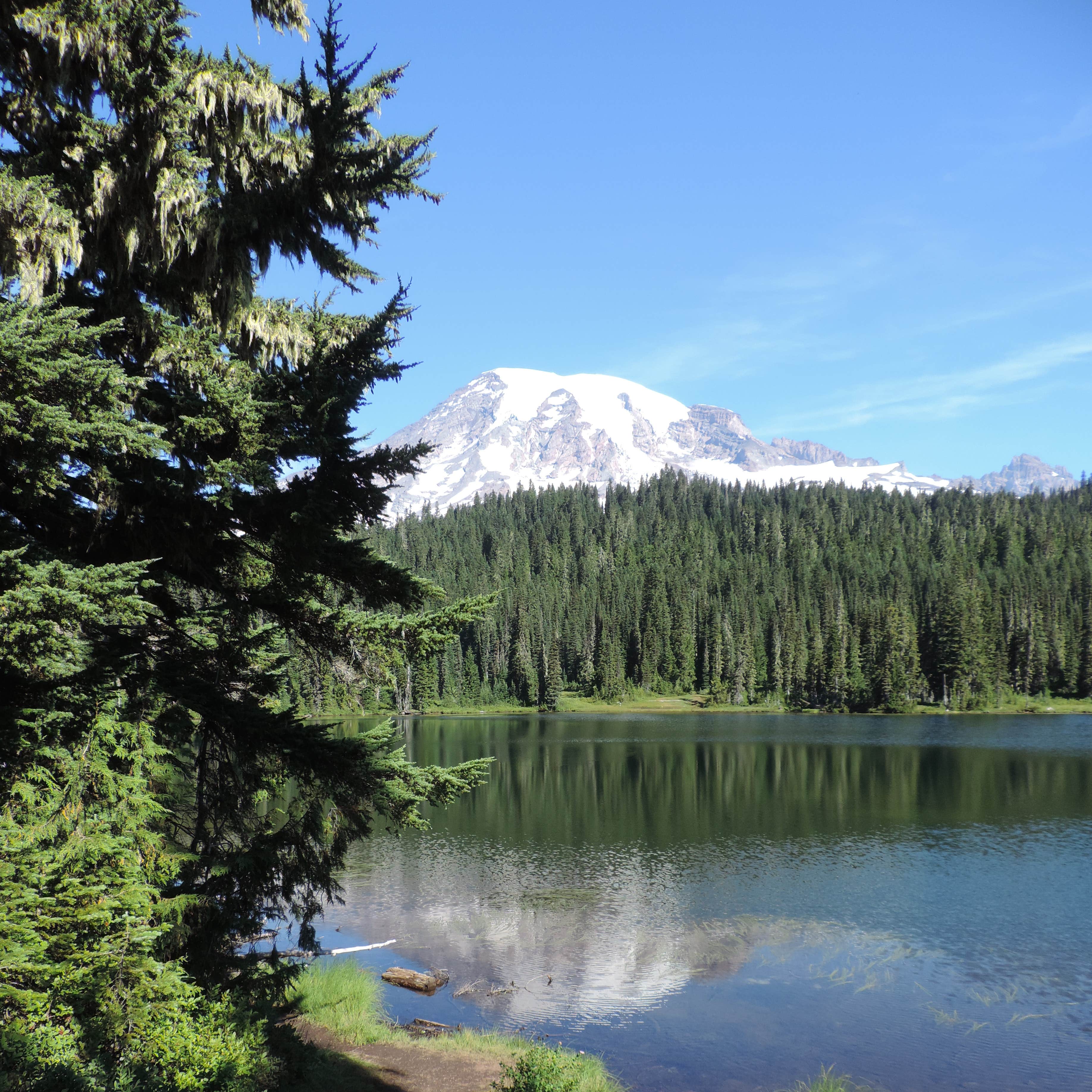
Cougar Rock Campground — Mount Rainier National Park
Cougar Rock Campground sits in the southwest corner of the park near Longmire and Paradise, offering 179 sites amid towering firs and cedars. At 3,180 feet elevation, it provides an ideal base for exploring Paradise's famous wildflower meadows and views of Mount Rainier, just 5 miles up the road. Campsites include picnic tables, fire rings, and bear-proof food lockers, with flush toilets and potable water available. An amphitheater hosts summer ranger talks. RVs up to 35 ft are accommodated (no hookups). The Nisqually River is a short walk away, and trailheads to Carter Falls and Rampart Ridge are nearby. Reservations are available in peak season, while early/late season sites are first-come, first-served.
Southeast (Ohanapecosh) Campgrounds
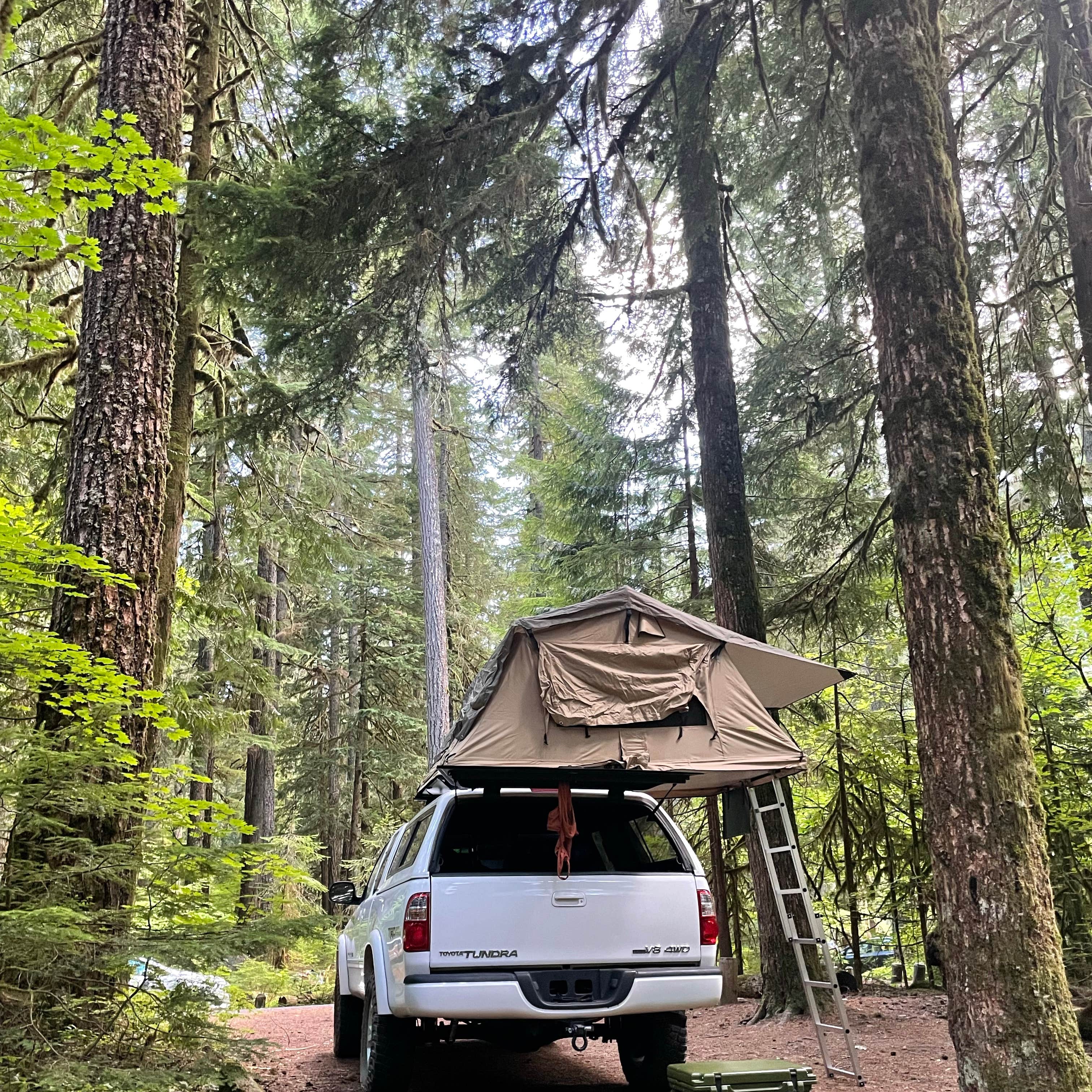
Ohanapecosh Campground — Mount Rainier National Park
Ohanapecosh Campground lies at 1,914 feet in the old-growth forests of the park's southeast corner. Its 188 sites sprawl along the Ohanapecosh River, creating a peaceful atmosphere with the sound of flowing water. Each site has a picnic table, fire grate, and food storage locker; restrooms provide flush toilets and drinking water (no showers). The campground's lower elevation means milder nights and lush greenery, and it's a short walk to the popular Silver Falls trail and Ohanapecosh Visitor Center. Sites in loops closest to the river are especially sought after for their scenery. RVs up to 32 ft can be accommodated but without hookups. 2025 Note: Closed for the season due to construction improvements, slated to reopen in 2026.
Northeast (Sunrise) Campgrounds
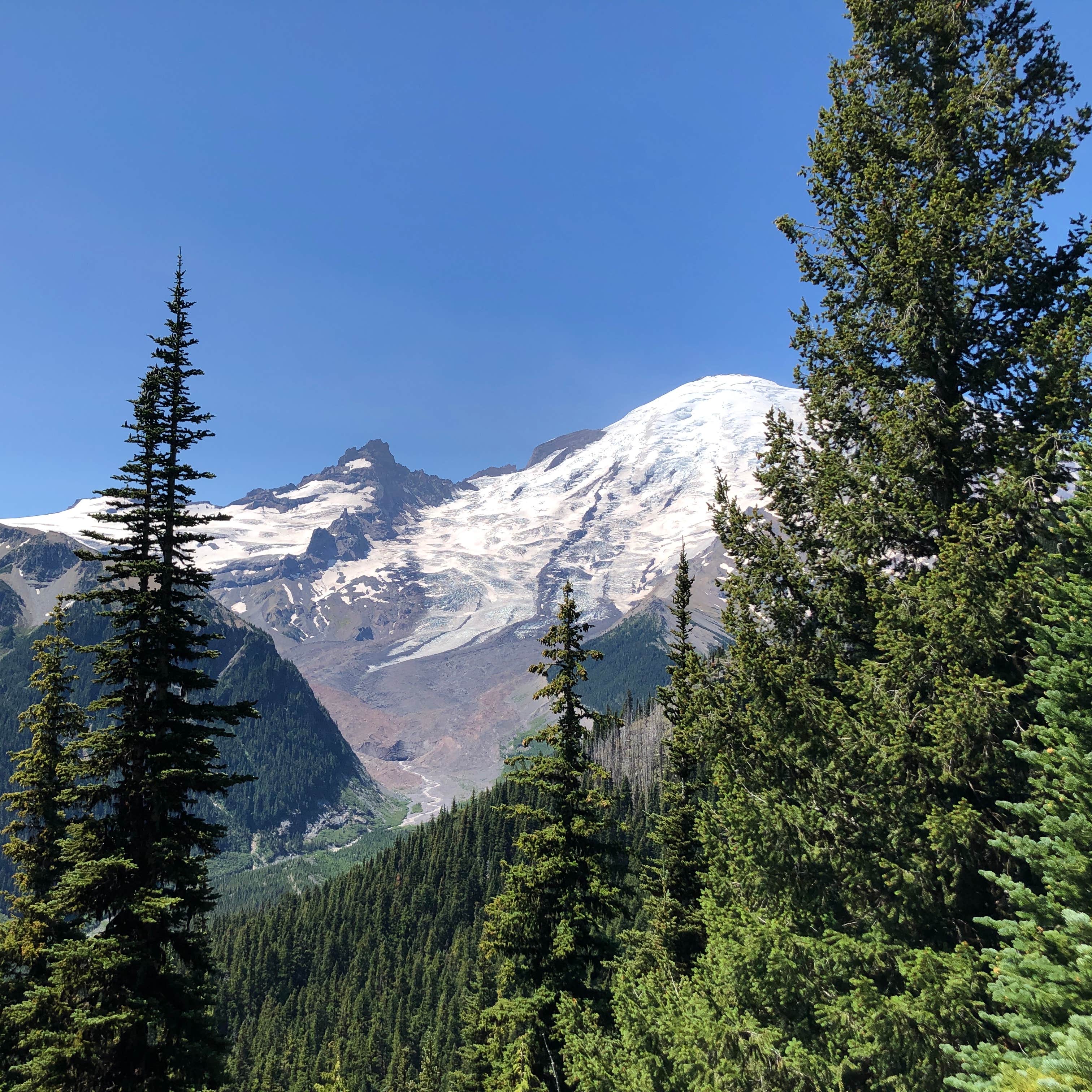
White River Campground — Mount Rainier National Park
White River Campground is tucked in the northeast part of Mount Rainier at 4,400 feet, offering 88 sites with a rugged alpine character. This first-come, first-served campground sits along the White River, and some sites have glimpses of Emmons Glacier on Rainier's slopes. Sites have picnic tables and fire rings; water and flush toilets are available (no RV dump station). The campground's higher elevation means cooler temperatures and a later opening (often late June). It directly accesses the Glacier Basin Trail from Loop D, making it a favorite for hikers. RVs over 27 ft are not recommended due to tighter turns and shorter pads. A timed-entry reservation for the Sunrise Road is required during summer peak hours, but your camping permit will serve as your entry pass after securing a site.
Northwest (Carbon River & Mowich Lake) Campgrounds
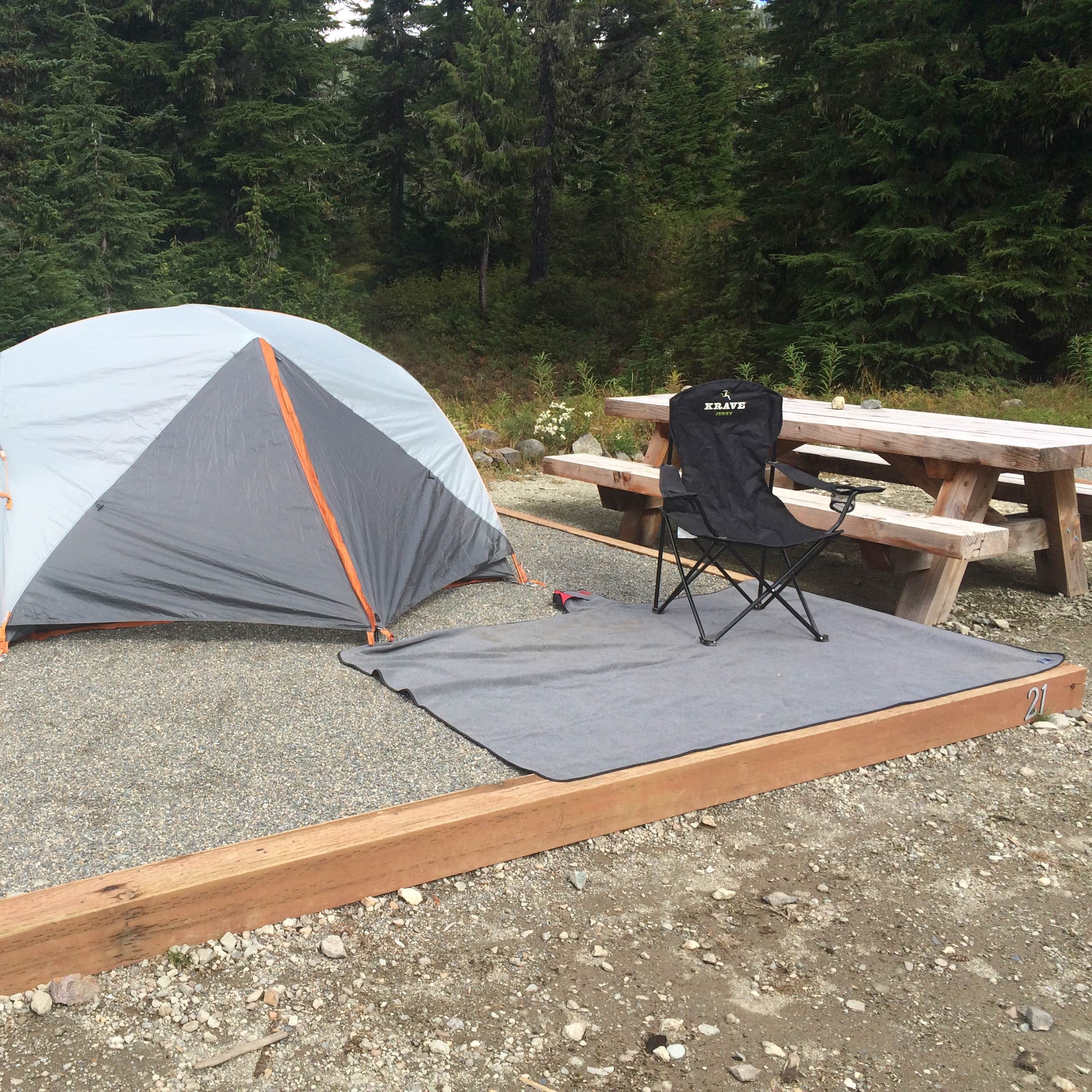
Mowich Lake Campground — Mount Rainier National Park
Mowich Lake Campground is a primitive, tents-only campground located at 4,929 feet in the park's remote northwest corner. It features 10-13 walk-in tent sites on a first-come basis (no fees). Each site has a picnic table and bear box, and vault toilets are available, but there is no potable water (campers must filter lake or stream water). The campground sits next to the crystal-clear Mowich Lake, offering stunning reflections of surrounding peaks and access to trails like Tolmie Peak and Spray Park. Campsites are close together with limited privacy, but the peaceful, backcountry atmosphere compensates. Campfires are prohibited here to protect the subalpine environment. 2025 Note: Road access is closed due to a bridge outage, so Mowich Lake is only reachable by backpacking (wilderness permit required).
Campground Comparison Table
| Campground | Location & Sites | Cost & Reservations |
|---|---|---|
| Cougar Rock | SW (Paradise area) 179 sites (loops A-E) | $20/night Recreation.gov (peak season) |
| Ohanapecosh | SE (Stevens Canyon) 188 sites (loops A-F) | $20/night Recreation.gov (peak season) |
| White River | NE (Sunrise area) 88 sites | $20/night First-come, first-served |
| Mowich Lake | NW (Mowich Lake Road) 13 walk-in tent sites | Free Wilderness permit required |
Campground Amenities and Best Uses
Reservable Campgrounds (Paradise & Ohanapecosh): Cougar Rock and Ohanapecosh campgrounds are the park's largest and most popular. Both offer full basic amenities (flush toilets, treated water, garbage service) and can accommodate tents and midsize RVs. Mount Rainier National Park tent camping at Cougar Rock is ideal for families and first-timers -- it's close to the Longmire Museum and Paradise area hikes, and features a summer amphitheater for ranger programs. Ohanapecosh, at a lower elevation, enjoys warmer nights and has trail access to Silver Falls and old-growth forests, making it perfect for campers who want a lush, wooded setting. These campgrounds take reservations in summer, ensuring peace of mind but requiring advance planning.
Sunrise Area (High Elevation): White River Campground provides a more rugged experience suited for hikers and adventurers. With no reservations, it's best for those who can arrive early to secure a spot. The reward is proximity to Sunrise's stunning viewpoints and trailheads -- you're minutes from the Sunrise Visitor Center and paths to Second Burroughs Mountain or Emmons Glacier overlooks. White River's campsites are smaller and the air is cooler and thinner, so it attracts tent campers and smaller RVs who don't mind the extra chill. This campground is a favorite for its outstanding scenery and access to alpine hikes, but campers should be prepared for cold nights and the need to store food diligently (bear lockers provided) due to active wildlife.
Primitive & Backcountry Options: For campers seeking solitude, Mount Rainier National Park dispersed camping at Mowich Lake and Ipsut Creek delivers. Mowich Lake Campground (walk-in only) offers a quiet, backcountry-like atmosphere on the shore of a pristine lake -- excellent for starry skies and early morning reflections of Rainier. There are no generators or campfires, preserving the tranquility. Similarly, Ipsut Creek former drive-in campground now serves as a backcountry camp 5 miles up the Carbon River trail, ideal for backpackers or cyclists looking to experience Rainier's rainforest in peace. Both options require self-sufficiency: bring water filtration, and be prepared to pack out all trash. They're best for experienced campers who relish isolation and don't need amenities.
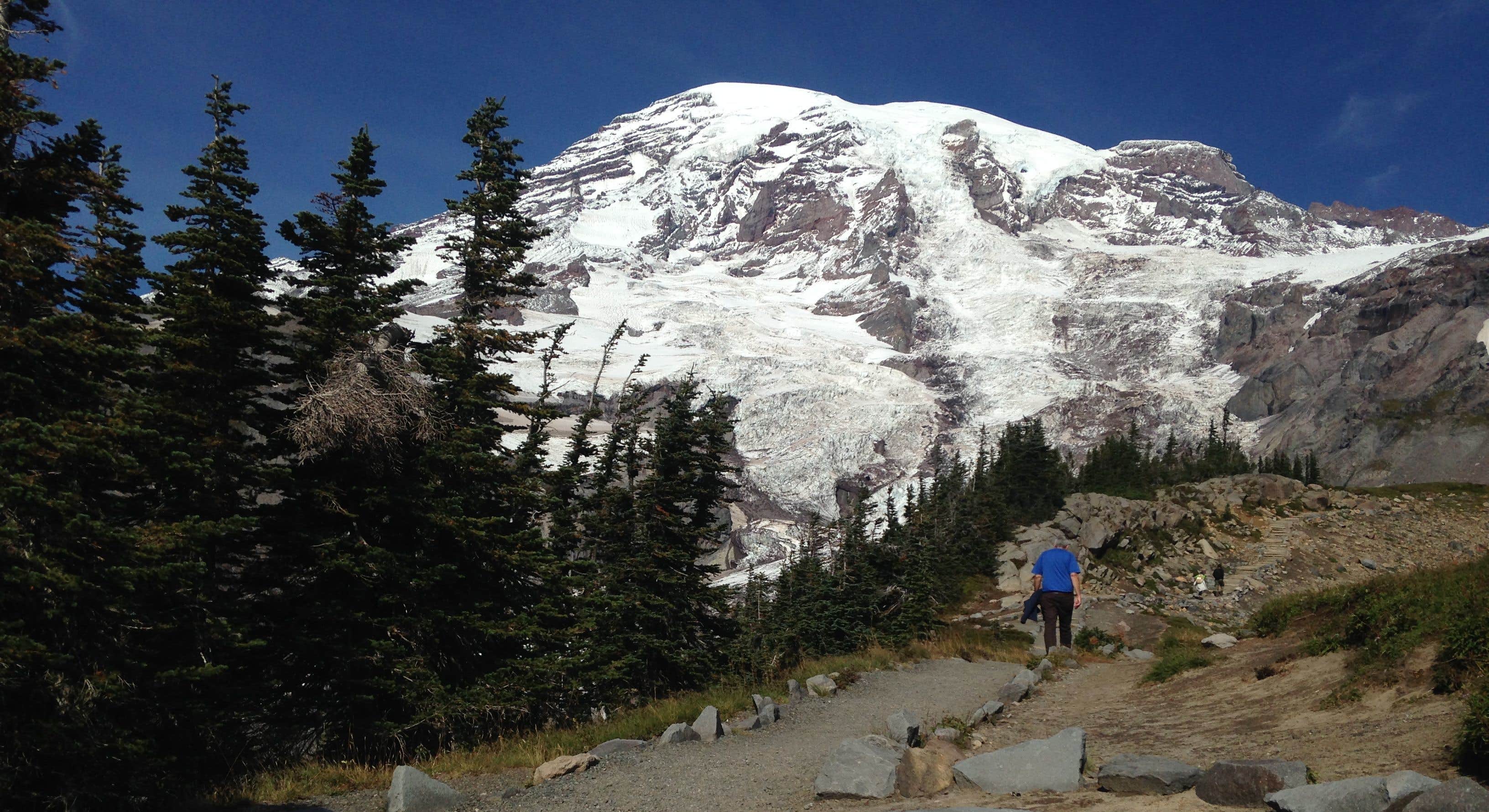 Photo by Bjorn S
Photo by Bjorn S
Planning Your Mount Rainier Camping Trip 
When to Visit Mount Rainier NP
| Season | Temperatures | Camping Conditions |
|---|---|---|
| Spring (April-May) | Days: 50-60°F Nights: 30-40°F (lower elevations) | Heavy snow persists at Paradise/Sunrise Cougar Rock & Ohanapecosh open late May (weather permitting) Early May camping limited to low elevations outside park |
| Summer (June-August) | Days: 65-80°F Nights: 35-50°F (cooler at Sunrise) | All campgrounds open by early July Peak crowds and full campgrounds, especially weekends Wildflowers bloom July-August; afternoon thunderstorms possible |
| Fall (September-October) | Days: 50-65°F Nights: 25-40°F | Most campgrounds close by late Sept Quieter weekdays, brilliant fall foliage (late Sept) Increasingly cold nights; first snow often by October |
| Winter (November-March) | Days: 30-45°F (low elevations) Nights: 15-30°F | No front-country campgrounds open (off-season) Backcountry winter camping allowed with permit Deep snowpack closes park roads; consider lower elevation NF sites |
Spring (April-May):
Early spring in Mount Rainier brings mild days at low elevations and deep snow in the high country. Park roads begin to reopen by May -- the Nisqually (Paradise) Road is usually plowed to Paradise by mid-April, while Sunrise Road stays closed until late June. Cougar Rock and Ohanapecosh Campgrounds typically open around the Memorial Day timeframe, but many trails at higher elevations remain snow-covered. Campers in spring should be prepared for chilly, wet conditions: rain is common, and temperatures at night can dip below freezing even in May. The upside is solitude -- April and early May see far fewer visitors, meaning nearby national forest campgrounds may have sites available if park campgrounds aren't open yet. Waterfalls and rivers run high with snowmelt, making this a great time to see cascades like Narada Falls in full force.
Summer (June-August):
Summer is peak season, offering the best weather and full access to the park -- but also the biggest crowds. By late June, all campgrounds (except possibly Mowich Lake) are open, and the famous wildflower meadows burst into bloom by mid-July. Daytime highs range from the 70s°F at Longmire and Ohanapecosh to the 50s-60s°F at Sunrise. Nights are cool everywhere (down into the 30s-40s°F). July and August weekends are extremely busy; campgrounds that accept reservations book up as soon as they become available, and White River Campground fills early each morning. To beat the rush, plan mid-week trips or arrive at first-come sites by mid-morning Thursday or earlier. Afternoon thunderstorms can roll in on hot days, especially in August, so having a quality rainfly and quick shelter plan is wise.
Fall (September-October):
Early fall brings a short window of crisp, clear weather and lighter crowds. After Labor Day, families depart and you'll find more last-minute campsite availability, especially on weekdays. September days are comfortably cool (50s-60s°F) and nights turn cold (often dipping to freezing by late September). Spectacular autumn color arrives in late September: huckleberry bushes on the slopes turn red, vine maples glow orange along Stevens Canyon, and larch trees beyond Sunrise turn golden in early October. Most campgrounds close by the end of September -- Cougar Rock and Ohanapecosh sometimes remain open into the first week of October if weather allows.
Winter (November-March):
Mount Rainier's winter is snowy and peaceful -- but front-country camping opportunities are extremely limited. All drive-in park campgrounds are closed, and deep snow (often 10+ feet) covers campgrounds like Cougar Rock until spring. Adventurous visitors can still winter camp with a Wilderness Permit, either by backpacking to designated snow camping areas (such as Reflection Lakes or Paradise meadows) or car-camping just outside the park. If you do winter camp, you must be self-sufficient: bring avalanche awareness, sub-zero rated gear, and be ready for harsh weather. The park maintains a snowplay area at Paradise on weekends and holidays (with warming hut access), but overnight campers should expect nighttime lows well below freezing (0-20°F on clear nights).
Mount Rainier Reservation Systems Explained
Securing a campsite at Mount Rainier requires understanding a mix of reservation and first-come, first-served systems:
Recreation.gov Reservations: Cougar Rock and Ohanapecosh Campgrounds accept reservations for roughly late June through early September. These can be booked on Recreation.gov up to 6 months in advance of the arrival date (rolling window), with new dates opening at 7:00 AM PT each day. Demand is high -- it's not uncommon for weekend sites to be fully reserved within minutes. To improve your chances, log in beforehand, have multiple date or campground options ready, and be prepared to book the moment reservations open. If you miss out, keep checking back; cancellations do pop up, especially 1-2 weeks before arrival as plans change.
First-Come, First-Served Campgrounds: White River Campground is FCFS for the entire season -- no advance reservations are offered. During summer, plan to arrive early in the day to snag a spot here (on busy days in July/August, it can fill by mid-morning). If you're aiming for a weekend, getting in by Thursday evening or very early Friday greatly increases your odds. Mowich Lake walk-in sites are also FCFS (with a self-issue permit at the trailhead kiosk), but road closure in 2025 means only hikers can reach it.
Timed Entry Permit (Sunrise Road): New in 2025, the park requires a timed-entry reservation to drive the Sunrise/White River Road between 7:00 AM and 5:00 PM on peak summer days (daily July 11-Sept 1, and on weekends through mid-October). This $2 permit (booked on Recreation.gov one week in advance, with some short-term releases 2 days prior) is not a campsite reservation, but it affects campers trying for White River. If you plan to arrive at White River Campground during those hours, you'll need a timed-entry pass unless you already secured a site earlier or arrive before 7 AM.
Campground Costs and Budgeting
| Campground Type | Nightly Cost | Key Features |
|---|---|---|
| Standard Park Campgrounds | $20 | Cougar Rock, Ohanapecosh, White River -- No hookups; includes table, fire ring, bear box, flush toilets, water |
| Primitive/Walk-In Sites | Free | Mowich Lake, Ipsut Creek -- No fee but require free permit; vault toilets or none; no water or fires; tent camping only |
| Group Campsites | $60 | Cougar Rock (5 sites), Ohanapecosh (2 sites) -- Tents only; accommodate 25-40 people; reservation required via Recreation.gov |
Additional Fees and Budget Tips
Park Entrance Fees: Mount Rainier NP charges $35 per vehicle for a 7-day pass (or $55 for an annual Rainier pass). If you plan to visit multiple national parks or return often, the $80 America the Beautiful Pass is a good investment and covers entry fees for a year at all national parks.
Senior & Access Pass Discounts: Holders of the Interagency Senior Pass or Access Pass receive a 50% discount on camping fees at Mount Rainier's campgrounds. Be sure to enter your pass number when booking on Recreation.gov or show your pass for first-come sites to get the reduced rate.
Firewood and Supplies: Firewood gathering is not allowed in the park, so you'll need to purchase wood if you want campfires (and fires are permitted only in provided rings). Wood bundles cost about $6-$8 from vendors at Longmire General Store, in Ashford or Packwood, or occasionally from camp hosts. Ice can be bought at Longmire, Sunrise Day Lodge, or nearby towns for ~$3-$5 per bag.
Budget-Friendly Camping: To save money, consider combining a few nights in the park with free camping on forest lands. Dispersed camping (no fee) is allowed in Mt. Baker-Snoqualmie and Gifford Pinchot National Forests just outside the park -- for instance, along Forest Road 70 or 73 near Greenwater, or off Skate Creek Road near Packwood.
Essential Gear for Mount Rainier Camping
Mount Rainier's variable weather and mix of high elevation and rainforest conditions mean you should pack thoughtfully:
Shelter and Sleeping:
- 4-season or sturdy 3-season tent with full rainfly and strong poles (rain, wind, or even early snow can occur, especially at Sunrise)
- Ground tarp or footprint to place under your tent
- Sleeping bag rated 10-20°F lower than expected temperatures (nights can drop into the 30s°F even in midsummer)
- Insulated sleeping pad (R-value 3 or higher) to buffer against cold ground
- Extra blankets or fleece liner for layering on colder nights
- Headlamp or flashlight (and spare batteries) for navigating at night
Cooking and Food Storage:
- Stove and fuel: Campfires may be restricted during dry periods
- Bear-safe food storage: All park campgrounds provide metal bear boxes at sites
- Cooler with ice: A high-quality cooler will keep food cold longer
- Water containers: Fill up at camp spigots for cooking and cleaning
- Biodegradable soap & wash basin for dishwashing
Clothing and Footwear:
- Layered clothing system: Weather can swing from warm sun to chilly rain quickly
- Rain gear: A quality rain jacket is essential
- Sturdy hiking boots or shoes with good traction
- Cold-weather items: Even in mid-summer, pack a warm hat, gloves, and thick socks
Other Essentials:
- Insect repellent for early summer
- Sun protection: High elevations mean stronger UV exposure
- Navigation and maps: Cell service is very limited
- First aid kit with basic supplies
- Bear spray (optional): While rarely needed in campgrounds
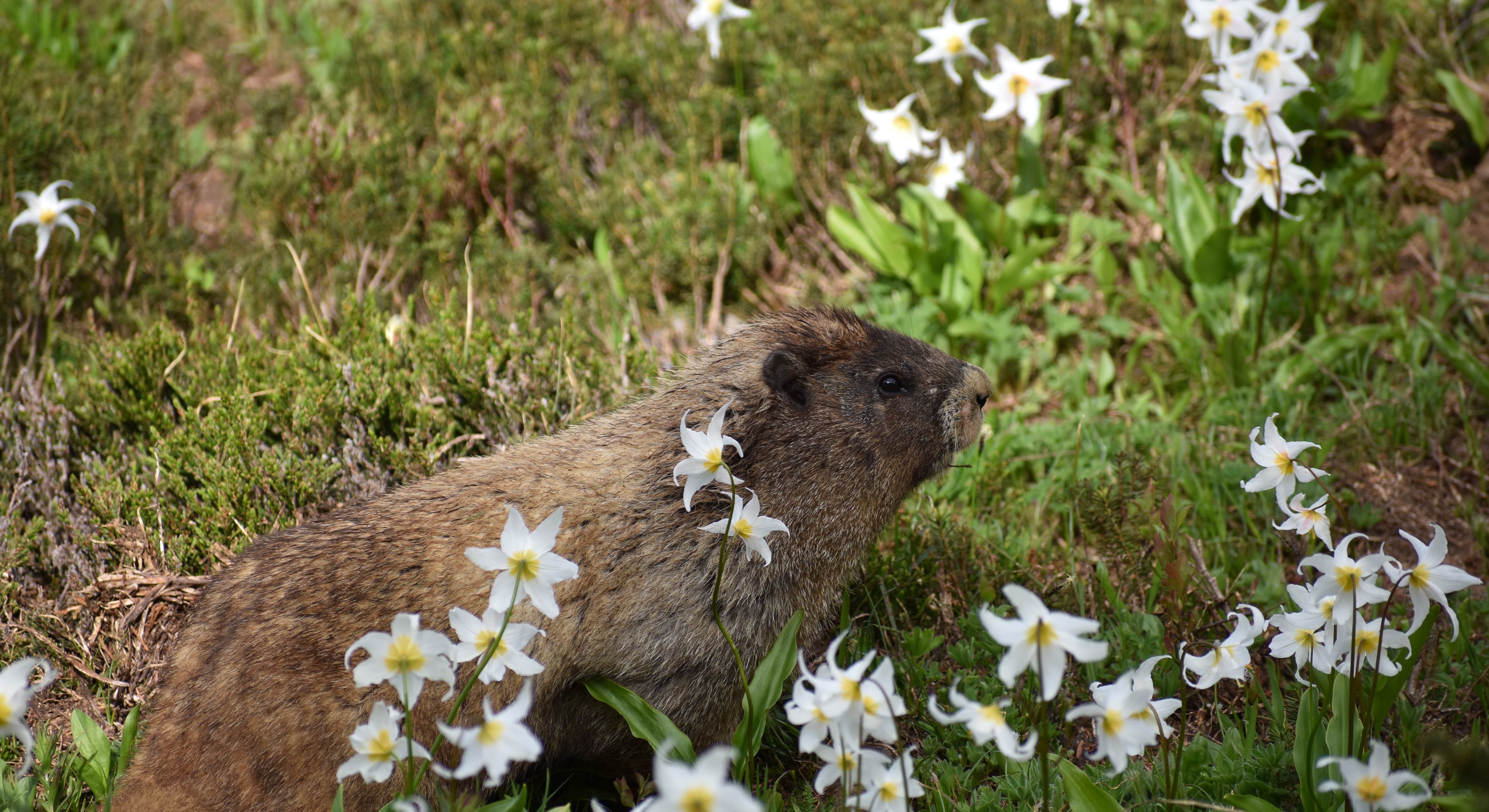 Photo by Terrie M
Photo by Terrie M
Wildlife Safety and Park Regulations 
Black Bear Safety in Mount Rainier
Mount Rainier is home to a healthy population of black bears, as well as other wildlife like elk, deer, and smaller critters. While black bears here tend to avoid humans, improper food storage can lead to dangerous encounters:
Food Storage Requirements:
- Use provided bear lockers at Cougar Rock, Ohanapecosh, and other campgrounds
- All food, drinks, cooking gear, trash, toiletries, and anything scented must be stored in these lockers whenever not in use
- Never leave coolers, food bags, or dirty cookware out
- No food in tents -- Do not bring snacks or even toothpaste into your sleeping tent
- Clean up promptly after cooking or eating
Wild Animal Encounters:
- Keep distance: Park rules require staying at least 50 yards from bears and 25 yards from other large animals
- Make noise if surprised: Black bears will usually flee if they know humans are around
- If a bear approaches your camp: Do not run. Make loud noises -- yell, bang pots, flash lights
- Secure children and pets: Never let kids wander alone at dusk or dawn
Park Regulations and Etiquette
| Regulation Category | Specific Rules | Penalties |
|---|---|---|
| Campfires | Allowed only in metal fire rings provided Do not leave fires unattended; fully extinguish with water No collecting wood -- use purchased/local firewood | Fines; Potential ban from campground for violations Campfire bans enacted in high fire danger (must obey or face fines) |
| Quiet Hours | 9:00 PM - 7:00 AM every day Generator use allowed only 8-10 AM, 12-2 PM, 5-7 PM (in loops permitting them) No loud music or amplified sound at any time | Rangers may issue warnings Repeat violations can result in citation or eviction from campground |
| Wildlife & Plants | Do not feed any wildlife (even squirrels or birds) Do not harass or approach animals; keep required distance Picking wildflowers or removing natural objects is prohibited | $100-$500 fines for feeding or disturbing wildlife Illegal removal of plants or rocks can result in hefty fines |
| Pets | Must be leashed (max 6 ft) at all times Not allowed on trails or in off-trail areas; only in campgrounds, roads, and parking areas Never leave pets unattended | Warnings or citations for off-leash or trail violations Repeated issues could lead to being asked to leave park |
Additional Mount Rainier Park Regulations
Camping Limits: A maximum of 6 people (or one immediate family) and 2 tents are allowed per standard campsite. You may not exceed 14 consecutive nights in any one campground, nor camp more than 28 nights total in the park in a calendar year.
Check-in/Check-out: Check-in time for reserved sites is typically 1:00 PM. Check-out time is 12:00 noon. For first-come sites, if you plan to extend your stay, make sure to re-register or pay for additional nights before the noon checkout.
Trash and Sanitation: Mount Rainier's motto is "Pack it in, pack it out" -- always leave your campsite as clean as or cleaner than you found it. Use the bear-proof dumpsters for garbage and the recycling bins for glass, aluminum, and plastics.
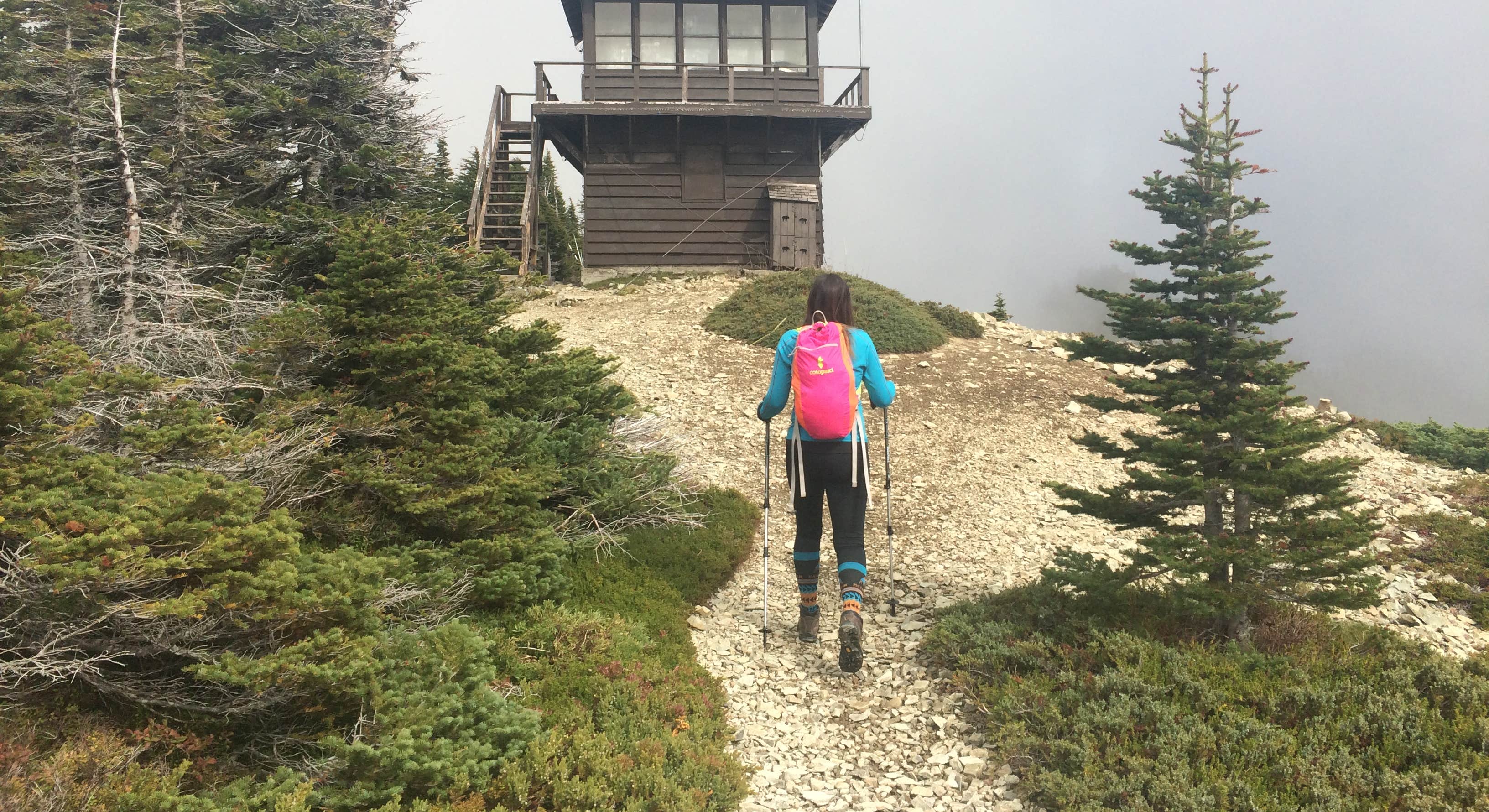 Photo by Jessie T
Photo by Jessie T
Beyond the Campground: Activities and Exploration 
Day Trips from Mount Rainier Campgrounds
From Cougar Rock (Paradise Area):
Being just 2 miles from Longmire and 5 miles from Paradise, Cougar Rock campers have a wealth of day trips at their fingertips. Paradise is a must -- drive up in the early morning (to beat crowds) and tackle the Skyline Trail, a 5.5-mile loop through subalpine wildflower meadows with unbeatable Mt. Rainier views and sights like Myrtle Falls. After hiking, visit the Paradise Jackson Visitor Center for exhibits and a cafeteria-style lunch with a panoramic window view. Closer to camp, visit the Longmire Historic District: you can walk the 0.7-mile Trail of the Shadows nature loop to see mineral springs and old-growth forest, then tour the 1916 Longmire Museum to learn about the park's history. In the evening, consider driving 3 miles to Narada Falls, where a short path leads to a stunning 176-foot waterfall.
From Ohanapecosh (Southeast Corner):
Ohanapecosh campers are near some of the park's best hidden gems. Start with the Silver Falls Loop, which begins right from the campground -- a 3-mile roundtrip hike through towering trees to a beautiful waterfall cascading into turquoise pools. A short drive up Stevens Canyon Road takes you to the Grove of the Patriarchs trailhead (when open -- currently closed for bridge repairs until 2027), where an easy stroll crosses a suspension bridge to an island of ancient, giant cedar and Douglas-fir trees. For a scenic drive, continue up Stevens Canyon Road: you'll pass Reflection Lakes (on a calm morning, see Mount Rainier mirrored in the water) and can continue to Paradise.
From White River (Sunrise Area):
White River Campground positions you near the alpine wonders of Sunrise. A must-do day trip is the drive up to Sunrise Point and Sunrise Visitor Center (about 3 miles uphill from camp). Stop at Sunrise Point for a 360-degree view that includes Mount Rainier, Mount Adams, and even Mount Baker on clear days. At Sunrise, hit the trails: ambitious hikers can trek to Second Burroughs Mountain (about 6 miles roundtrip) for one of the closest views of Mount Rainier's summit and glaciers. Another fantastic hike starting right at the campground is Glacier Basin Trail -- 6 miles roundtrip following the White River to an amphitheater of glaciers and peaks.
Top Hiking Trails Near Mount Rainier Campgrounds
| Trail Name | Difficulty & Distance | Key Features |
|---|---|---|
| Skyline Trail (Paradise) | Strenuous 5.5 miles loop | Iconic alpine meadows and panoramic views from Paradise Passes Myrtle Falls, Glacier Vista, and Panorama Point (elevation 6,800') |
| Silver Falls Loop (Ohanapecosh) | Easy 3 miles loop | Lush old-growth forest hike starting in Ohanapecosh Campground Scenic Silver Falls cascading through a rocky gorge |
| Glacier Basin Trail (White River) | Moderate 6 miles roundtrip | Follows glacial White River to an alpine basin below Emmons Glacier Wildflowers, possible wildlife (marmots, goats), and mining history remnants |
| Burroughs Mountain Trail (Sunrise) | Moderate/Strenuous 5-7 miles roundtrip | High-elevation trek to treeless volcanic ridge Unparalleled close-up views of Mount Rainier and its glaciers; often wildlife sightings |
| Naches Peak Loop (Chinook Pass) | Easy 3.4 miles loop | Family-friendly loop skirting Tipsoo Lake just outside SE park boundary Fabulous views of Rainier, vibrant wildflowers in summer; part of trail on Pacific Crest Trail |
Trail Access and Starting Points
Paradise Area (Cougar Rock): The Skyline Trail and other Paradise trails begin at the Paradise parking area, about a 20-minute drive from Cougar Rock Campground. Parking fills quickly (often by mid-morning in summer), so camp guests should plan an early departure. The Cougar Rock area also provides trailheads: the Comet Falls Trail starts 4 miles west of camp on the Paradise road (a steep hike to one of the park's tallest waterfalls), and the Rampart Ridge Trail begins right at Longmire, offering a moderate climb to an overlook of the valley and camp below.
Ohanapecosh Area: The Silver Falls Loop can be started directly from Ohanapecosh Campground (trailheads near Loop B or from the Ohanapecosh Visitor Center). For other hikes, the Laughingwater Creek Trail departs near the campground entrance, leading 7+ miles toward Three Lakes. To reach trails at Tipsoo Lake/Naches Peak, drive 17 miles north on Hwy 123 to Chinook Pass.
Sunrise/White River Area: Glacier Basin Trail conveniently starts at the White River Campground -- look for the trailhead at the end of Loop D. It doubles as part of the Wonderland Trail, so watch for backpackers along the way. For the Sunrise trails (Burroughs, Sourdough Ridge, Frozen Lake, etc.), drive or hike 3 miles up the road from the campground to the Sunrise parking lot.
Fishing, Water Sports, and Other Activities
Mount Rainier isn't known for big water recreation, but there are still a few ways to enjoy the park's rivers and lakes:
Fishing: Anglers can fish park waters with a Washington state fishing license (no special park permit needed). The Ohanapecosh River, White River, and Carbon River have populations of small rainbow and brook trout. Popular spots include casting in the pools below Silver Falls (Ohanapecosh) or along the White River near the campground. Higher elevation lakes like Shadow Lake (near Sunrise) or Reflection Lakes have trout as well.
Swimming: Due to cold temperatures, swimming is limited. Lakes like Mowich and Reflection rarely get above 50°F; a quick dip can be refreshing on a hot August day, but prolonged swimming isn't common. A safer bet for wading is the Ohanapecosh River on a warm afternoon -- campers often wade into shallow pools near Ohanapecosh Campground.
Wildlife Watching: Each campground area has nearby hotspots for wildlife. From Cougar Rock, drive at dusk to the Longmire meadows to look for elk grazing. Ohanapecosh campers sometimes spot mountain goats on the cliffs across the river. At White River, keep an eye out for deer nibbling around the campground and for marmots sunning on rocks near Glacier Basin.
Evening Programs & Stargazing: In summer, ranger-led evening programs are offered at Cougar Rock (Paradise area) and Ohanapecosh amphitheaters multiple times a week. After dark, Mount Rainier's skies can be incredible. The park has very low light pollution -- at White River or Mowich, the Milky Way is often clearly visible on moonless nights.
The Dyrt Community Insights 
Ranger Recommendations
The Dyrt Rangers -- seasoned campers with extensive national park experience -- offer these insider tips for Mount Rainier:
Best Sites at Ohanapecosh Campground:
"Ohanapecosh is our family favorite, and loops E and F along the river are the prime spots," notes one Dyrt Ranger who visits Rainier annually. Sites in Loop E, especially those backing onto the Ohanapecosh River (like E11-E15), offer soothing river sounds and quick access to the trail for Silver Falls. Rangers also mention that Loop F tends to be a bit quieter and more secluded, with huge trees between sites.
Hidden Gem Campground:
"Mowich Lake Campground doesn't get enough love," according to another The Dyrt Ranger. Tucked in the park's northwest corner, Mowich is often bypassed by visitors due to its rough gravel road (and now a closure), but those who venture there are rewarded. "It's primitive, yes -- no potable water, no campfires -- but you're camping by a stunning alpine lake with hardly anyone around," they explain.
Free Camping Favorite:
Rangers agree that some of the best free camping near Rainier is along Forest Road 70/73 near the White River entrance. One Ranger highlights the dispersed sites along Huckleberry Creek (off FR 73): "If White River Campground is full, drive 10 minutes out of the park and you'll find pull-offs by the river where you can camp under big trees for $0."
Private Campground Perks:
For those willing to spend a bit more, The Village at Rainier and other private options come highly recommended by Rangers and community members alike. "After a week of no showers, that first hot shower felt amazing," shares a Ranger who often splits trips between national park sites and a night at a private campground.
Top-Rated Sites from The Dyrt Community
| Category | Top Pick & Rating | Key Highlights |
|---|---|---|
| Highest-Rated In-Park | Ohanapecosh Campground 4.8/5 stars | Soaring old-growth forest setting, riverside ambiance, central to Paradise & Sunrise areas (when open) |
| Best for Mountain Views | White River Campground 4.6/5 stars | Only campground near treeline, direct vista of Emmons Glacier, trail access to Sunrise and Glacier Basin |
| Most Secluded Experience | Mowich Lake Campground 4.4/5 stars | No crowds, no fee -- primitive tent pads by a pristine alpine lake, spectacular night skies (no light pollution) |
| Most Family-Friendly | Cougar Rock Campground 4.5/5 stars | Big trees and flat tent pads, close to visitor center and easy trails, ranger programs on-site, flush toilets |
Community Insights and Recommendations
Ohanapecosh Applause: Campers consistently rave about Ohanapecosh Campground's atmosphere -- the word "magical" comes up often in reviews. Visitors love being immersed in an ancient forest with mossy trees and the gentle sound of the river. Many mention the Silver Falls Loop as a favorite activity right from their campsite.
High Elevation Highlights: The Dyrt community gives high marks to White River Campground for its scenery. Several reviewers were pleasantly surprised by how close you feel to Mount Rainier -- one said, "Waking up to the sight of the mountain glowing at sunrise was unforgettable."
Quiet Corners: For those seeking solitude, community reviews point toward Mowich Lake and Ipsut Creek (Carbon River) as unparalleled. "We had Mowich almost to ourselves on a Monday night," said one user, who acknowledged the sites are close together but found fellow campers very respectful.
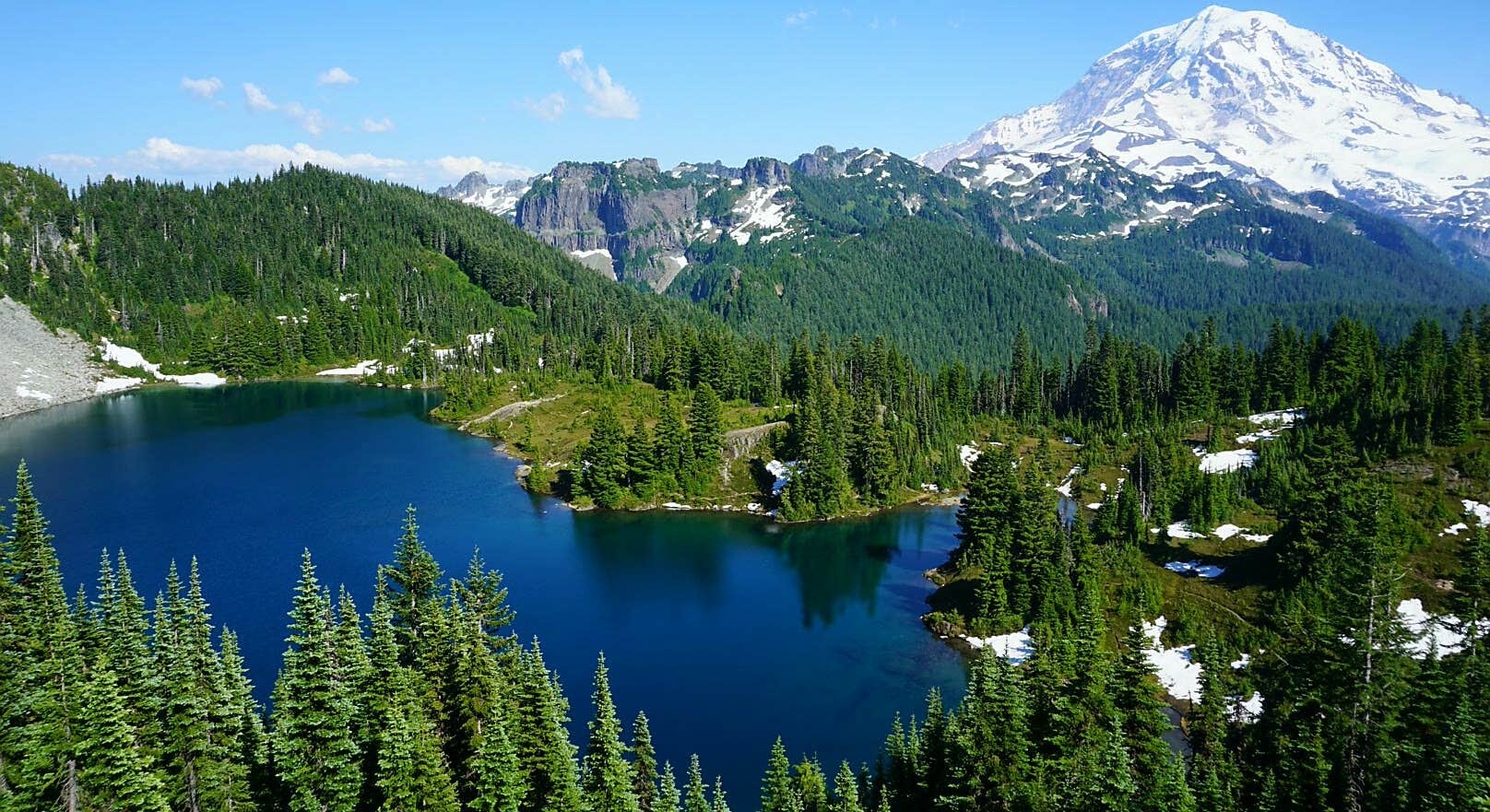
Responsible Camping Practices 
Camping in Mount Rainier's ecosystem comes with the responsibility to minimize your impact on the environment and be considerate of others:
Wildlife Protection:
- Store all food and garbage securely using bear lockers or a hard-sided vehicle
- Never feed animals -- it teaches bad habits and poor nutrition
- Keep a clean camp and pick up any food scraps or spills immediately
- Report unusual wildlife encounters to rangers
Leave No Trace:
- Stay on established areas and use existing campsites
- Respect posted closures and restoration areas
- Minimize campfire impact by using provided fire rings and keeping fires small
- Pack out what you pack in, including all trash and leftover food
- Leave natural objects where you find them
Water and Waste:
- Protect water sources from contamination by washing at least 200 feet from streams
- Use restrooms or cat holes properly (200 feet from water and camp)
- Conserve water at camp, especially in late summer
- No bathing in streams or lakes with soap
Camp Etiquette:
- Use headlamps with red light settings for moving around camp after dark
- Keep general noise level low and observe quiet hours (9:00 PM - 7:00 AM)
- Be considerate with generators and RV engines
- Leave your campsite cleaner than you found it
Frequently Asked Questions 
When do Mount Rainier campground reservations open, and how quickly do they fill? For Cougar Rock and Ohanapecosh, the reservation window opens 6 months in advance of the arrival date on Recreation.gov (rolling release at 7 AM PT each day). In recent years, demand is extremely high -- many July/August dates book out within minutes. Weekends and riverside loops are the first to go. If you can't snag a site at first, check back frequently, especially 1-2 weeks before your trip when people cancel to avoid fees.
Are there any first-come, first-served campgrounds in Mount Rainier? Yes. White River Campground is entirely first-come, first-served for its 88 sites all season long. In addition, Cougar Rock and Ohanapecosh have first-come sites during the shoulder seasons (typically opening few weeks and after Labor Day, until they close for winter). Mowich Lake Campground is also first-come (free permits at site), but it requires driving a rough road (when open) or hiking in.
What's the best campground for families with young children? Cougar Rock Campground is often considered the most family-friendly. It has a convenient location to attractions (short drive to Paradise for easy meadow trails and visitor centers), flush toilets and running water, and an amphitheater that hosts educational ranger programs ideal for kids. Another good option is Ohanapecosh, which has the advantage of a lower elevation (warmer nights for little ones) and the Ohanapecosh River to play near.
Can I camp in Mount Rainier in winter? Yes, but not in the traditional drive-in campgrounds. All summer campgrounds close by mid-October at the latest. Winter camping is allowed in the park's backcountry and in certain plowed parking areas by permit. For example, Paradise area allows snow camping with a free wilderness permit. If you're not up for that, you can camp just outside the park: some lower elevation campgrounds near Ashford or along Hwy 410 remain open year-round.
How do I protect my food from bears while camping? Mount Rainier campgrounds provide metal bear-proof storage lockers at each site. Using them is the single best way to secure your food. As soon as you arrive at camp, unload all your coolers, food bags, and scented items into the locker. Never leave food unattended on picnic tables. If you're in the backcountry, you should carry a bear canister or hang food in a durable dry sack at least 12 feet off the ground.
What should I do if I can't get a campsite in the park? Consider camping just outside the park. National forest campgrounds (like Big Creek, La Wis Wis, and Silver Springs) are within a 10-20 minute drive of park entrances. Mount Rainier National Park RV camping options and cabin rentals near Mount Rainier are also available in gateway communities. Dispersed camping on national forest land is free and allowed in many areas. Look into private campgrounds/RV parks in gateway communities like Ashford, Packwood, and Enumclaw.
Planning Resources
Essential Mount Rainier Links
- Find Mount Rainier Campgrounds by Camp Type - Real user reviews, campground availability, photos, and more in and around Mount Rainier
- Mount Rainier National Park Official Website - Current conditions, alerts, and regulations
- Recreation.gov Mount Rainier Campgrounds - Booking platform for all reservable Mount Rainier campgrounds
- Mount Rainier Road and Weather Conditions - Current updates on road status and weather
- Washington Trails Association - Trail reports and hiking information in and around Mount Rainier
- WSDOT Road Conditions - Highway information for approaching the Mount Rainier NP
Mount Rainier Reservation Guide/Timeline
| Time Period | Reservation Task | Platform/Details |
|---|---|---|
| 6 Months Before Trip | Book park campgrounds | Recreation.gov (opens 7:00 AM PT daily rolling window) Set calendar reminder for exact opening date |
| 3-4 Months Before | Reserve alternative options and book activities | National Forest campgrounds via Recreation.gov Private campground websites |
| 1-2 Months Before | Research first-come options and check for cancellations | Check Recreation.gov regularly for cancellations Plan backup forest campgrounds |
| 2-3 Weeks Before | Check current conditions and confirm reservations | NPS current conditions page Recreation.gov reservation management |
| 1 Week Before | Book timed-entry permit if needed | Recreation.gov for Sunrise Road access (summer only) |
| Day Before Arrival | Check road conditions and download offline maps | WSDOT and NPS websites GPS or map apps |
Mount Rainier Camping Checklist
Reservations and Permits:
- Campground reservation confirmation (printed and digital copy)
- Park entrance pass or America the Beautiful Pass
- Timed-entry permit for Sunrise (if visiting summer)
- Photo ID that matches reservation
- Washington fishing license (if fishing)
Camping Gear:
- 4-season or sturdy 3-season tent with rainfly and footprint
- Sleeping bag rated for cold temperatures
- Insulated sleeping pad (R-value 3+)
- Extra blankets or sleeping bag liner
- Headlamp or flashlight with extra batteries
- Lantern and/or string lights
- Camp chairs and table (if not provided)
Kitchen Items:
- Camp stove and fuel
- Lighter/matches in waterproof container
- Cooler and ice
- Water containers and filtration system
- Dish washing supplies (biodegradable soap, basin)
- Cookware and utensils
- Eating utensils, plates, and cups
- Food storage containers
Clothing:
- Moisture-wicking base layers
- Insulating mid-layers (fleece, down)
- Waterproof/windproof jacket
- Rain pants
- Hiking pants/shorts
- Extra socks and underwear
- Warm hat and gloves
- Sturdy hiking boots
- Camp shoes/sandals
Safety and First Aid:
- First aid kit including blister treatment
- Prescription medications
- Sunscreen and lip balm with SPF
- Insect repellent
- Basic tools and repair kit
- Toilet paper and hand sanitizer
- Whistle for emergencies
Navigation and Communication:
- Printed reservations and maps
- Offline maps downloaded to phone
- Portable phone charger
- Emergency contact information
- Park map and compass
By planning thoroughly and following park guidelines, your Mount Rainier National Park camping experience can be both enjoyable and responsible. The park's varied campgrounds offer experiences ranging from riverside forest settings to high alpine locations near glaciers. Whether you're watching the alpenglow on Mount Rainier from your campsite, hiking through wildflower meadows, or listening to the White River's roar from your tent, camping at Mount Rainier connects you directly to the Pacific Northwest's most iconic peak. For those seeking even more adventure, Mount Rainier glamping and horse camping near Mount Rainier provide unique ways to experience this remarkable national park.

